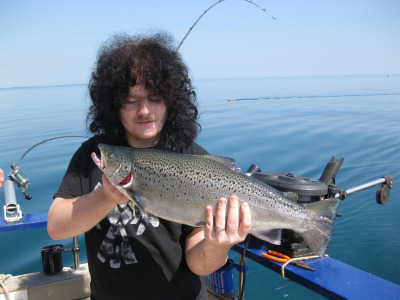Catch more salmon and trout this summer. Part 3, Spring Brown Trout on Lake Michigan
Captain Andy Derwinski
JEDI Sportfishing Charters
Kenosha, WI
I can't remember a winter that seemed to last so long. Finally after 3 days in the 50s, I can see my lawn for the first time since November. Yes, spring is in the air.
Now is when the cabin fever really sets in. I'm realizing the days are numbered before the JEDI hits the water again. It's time to finish the trolling reel overhauls, equipment repairs, and get started on prepping the boat for the 2010 season.
Open water trolling begins in March along the Indiana shoreline and April up here in Wisconsin. These next 2 months offer some of the best brown trout fishing of the year. Jigging in the harbors has become very popular over the last few years. There are several good guides available in many of the ports. However, my focus remains on trolling. Over the years I have caught browns from every harbor from St Joe around to Milwaukee. Every one of them offers an excellent spring fishery when the conditions are right.
The best plan of attack is "search and destroy". As the water warms, browns begin feeding heavily. By the time I am fishing, water can be anywhere from 35 to 45 degrees. Small pockets of warmer water can form near river mouths, harbor mouths, warm water discharges, and rocky shorelines such as breakwalls. Coastwatch.noaa.gov on the web can be used to find the spots, providing the skies are clear. Cloud cover blocks the satellite imagery and limits the data available. Watch your temp gauge closely. You'll be surprised how quickly a pier or concrete wall can warm the water on a sunny day in March. That warm water gets the bait moving in search of food. The browns are never far behind.
As far as a program for these fish, I keep it simple. I count on 6 basic lures to get the fish to bite. Magnum spoons in blue and silver, standard spoons in blue or green, and the small 2" Redeye from Eppinger. For plugs I count on jointed Rapalas, Yoruzi Minnows, and Wally Divers.
I'll start with orange jointed Rapalas, size 9 and 11. These will run 20 to 40 feet behind the planer boards on 1 side of the boat. The other side will have magnum spoons. My go-to spoon is a magnum Pro King OZ. That's the blue and silver with the red eye. These will also be 20 to 40 feet back with a or 3/8 oz sinker in front. I'm fishing very shallow, maybe as little as 8 feet. I tend to stay with just 2 riggers this shallow. Both will have a spoon, one short at 10 feet and one at least 100 back. Finally the 2 dipseys will have spoons or Rapalas, run just deep enough to disappear in the normally dirty spring water.
The key is to keep moving along the shore until the active schools are found. I usually zig zag between 8 and 25 feet. As I move through areas that have held fish in past years, I pay attention to which lures are getting hit. The water is shallow so these schools will spread out to both sides of the boat. The sides not getting hit get changed rather quickly. If the magnum spoons are dead, I switch to small spoons like the redeye or stingers. If the Rapalas are dead, I switch to the Yozuris, then the Wally Divers. Once active fish are located, I cut back on the lines in the water. I start with 4 planers per side and will cut back to 3 each, 2 if the fish are very active. The dipseys come out as sure as I am convinced that I am fishing the right depth. When things get busy, the last thing I want to worry about is hanging a dipsey on the bottom. Plus, a 10 pound brown hooked up on an outside planer board could easily wipe out the entire spread. Yes, I know this from experience. The 2 riggers stay in but I shorten the longer lead to about 25 feet. If I move deeper, past 20 feet, I usually add 2 more riggers. If you find one lure is doing all the work, don't be afraid to change the others out.
One important point: when very shallow, make sure the spoons behind the boards are all on one side of the boat. Make your turns away from that side. They'll move faster on the outside through the turn. If they are on the inside of the turn, they'll drop down and you risk snagging the bottom. With the floating plugs on the inside of the turn, you won't have that problem.
Keep it simple and stick to what works. Keep moving till active fish are found. And did I mention the Redeye? The 2 inch nickel or brass can be deadly. Take off the front hook.
Next month we'll discuss coho. Just in time!
Feel free to contact me for local reports for the Kenosha area. I don't normally respond to text messages, a call is always better. For more info on the lake and what it has to offer, check the website at http://www.jedisportfishing.com
The JEDI fishes daily from late April through October for salmon and trout from the Port of Kenosha. Kenosha is consistently ranked the best charter fishing port in Wisconsin by the Wisconsin DNR.
I am Captain Andy Derwinski, owner and captain of the JEDI. For the best adventure on the lake, give me a call. 414-788-6603


